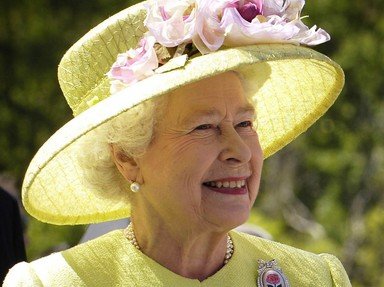Quiz Answer Key and Fun Facts
1. "Elizabeth II," - In 1952, the then Princess Elizabeth was waved off by her father, King George VI, on a planned tour of Australia and New Zealand. In which country had she stopped over when she was told that her father had died and she had become queen?
2. "By the Grace of God" - The phrase "By the Grace of God" has been used over the course of many centuries in England, and subsequently Great Britain, to establish the idea that the monarch rules by divine right. Who was the first monarch to incorporate the phrase as part of the royal title?
3. "of the United Kingdom" - The modern United Kingdom, with four constituent countries, was founded in 1801 through the union of three historic kingdoms in the British Isles. Which of the four constituents was never a kingdom in its own right?
4. "of Great Britain" - The idea of Great Britain as a single political entity was first suggested by King James I following his accession in 1603, but under the reign of which of his successors did it become a reality?
5. "and Northern Ireland" - In 1921, the island of Ireland was partitioned into two separate entities, with six counties in the north-east being formed into what became known as Northern Ireland. Which of the following counties does not border the Republic of Ireland?
6. "and of Her Other Realms" - The United Kingdom shares its monarch with a number of other countries around the world in a system called a "shared monarchy". Which was the last country in the 20th century to choose to remove Elizabeth II as its head of state and replace her with an elected president?
7. "and Territories" - The United Kingdom retains responsibility for a number of Overseas Territories, which are the remnants of the old British Empire in that their relationship is more akin to a colonial one. Two of these are to be found in Europe; Gibraltar is one, but on which island is the other located?
8. "Queen," - Although Mary I is recognised as the first queen regnant (that is a queen reigning in her own right) in England, the first woman to lay claim to the title of Queen, the Empress Matilda, did so more than 400 years earlier. She was the daughter of which king?
9. "Head of the Commonwealth," - The Commonwealth of Nations is an organisation that established itself following the independence of territories that had previously been part of the British Empire. Which country was the first to join the Commonwealth without having a previous colonial or constitutional link to the United Kingdom or any other Commonwealth member?
10. "Defender of the Faith" - In 1521, as a result of his staunch defence of the Catholic Church, Henry VIII was rewarded with the title "Defender of the Faith" by which pope?
Source: Author
Red_John
This quiz was reviewed by FunTrivia editor
gtho4 before going online.
Any errors found in FunTrivia content are routinely corrected through our feedback system.

